2022 HYUNDAI ELANTRA HYBRID warning
[x] Cancel search: warningPage 416 of 529

07
7-119
Reverse Parking Collision-
Avoidance Assist Operation
Operating conditions
If ‘Active Assist’ or ‘Warning Only’ is set
from the Settings menu, Reverse Parking
Collision-Avoidance Assist will be in
the ready status when the following
conditions are satisfied: - The tailgate is closed
- The gear is shifted to R (Reverse)
- Vehicle speed is below 10 km/h (6 mph)
- Reverse Parking Collision-Avoidance Assist components such as the rear
view camera and the rear ultrasonic
sensors are in normal conditions
Warning Only
• If Reverse Parking Collision-Avoidance
Assist detects a risk of collision with
a pedestrian or an object, Reverse
Parking Collision-Avoidance Assist
will warn the driver with an audible
warning, steering wheel vibration
and warning message on the cluster.
When Rear View Monitor is operating,
a warning will appear on the
infotainment system screen.
• ‘If ‘Warning Only’ is selected, braking will not be assisted.
• The warning will turn off when the
gear is shifted to P (Park), N (Neutral)
or D (Drive).
Active Assist
• If Reverse Parking Collision-Avoidance
Assist detects a risk of collision with
a pedestrian or an object, Reverse
Parking Collision-Avoidance Assist
will warn the driver with an audible
warning, steering wheel vibration
and warning message on the cluster.
When Rear View Monitor is operating,
a warning will appear on the
infotainment system screen.
• If Reverse Parking Collision-Avoidance
Assist detects imminent collision with
a pedestrian or an object behind the
vehicle, Reverse Parking Collision-
Avoidance Assist will assist you with
braking. The driver needs to pay
attention as the brake assist will end
within 2 seconds. The driver must
immediately depress the brake pedal
and check vehicle surroundings.
• Brake control will end when:
- The gear is shifted to P (Park) or D (Drive).
- The driver depresses the brake pedal with sufficient power
- Braking assist has last for approximately 2 seconds
• The warning will turn off when:
- The driver shifts the gear to P (Park), N (Neutral), or D (Drive)
Page 417 of 529
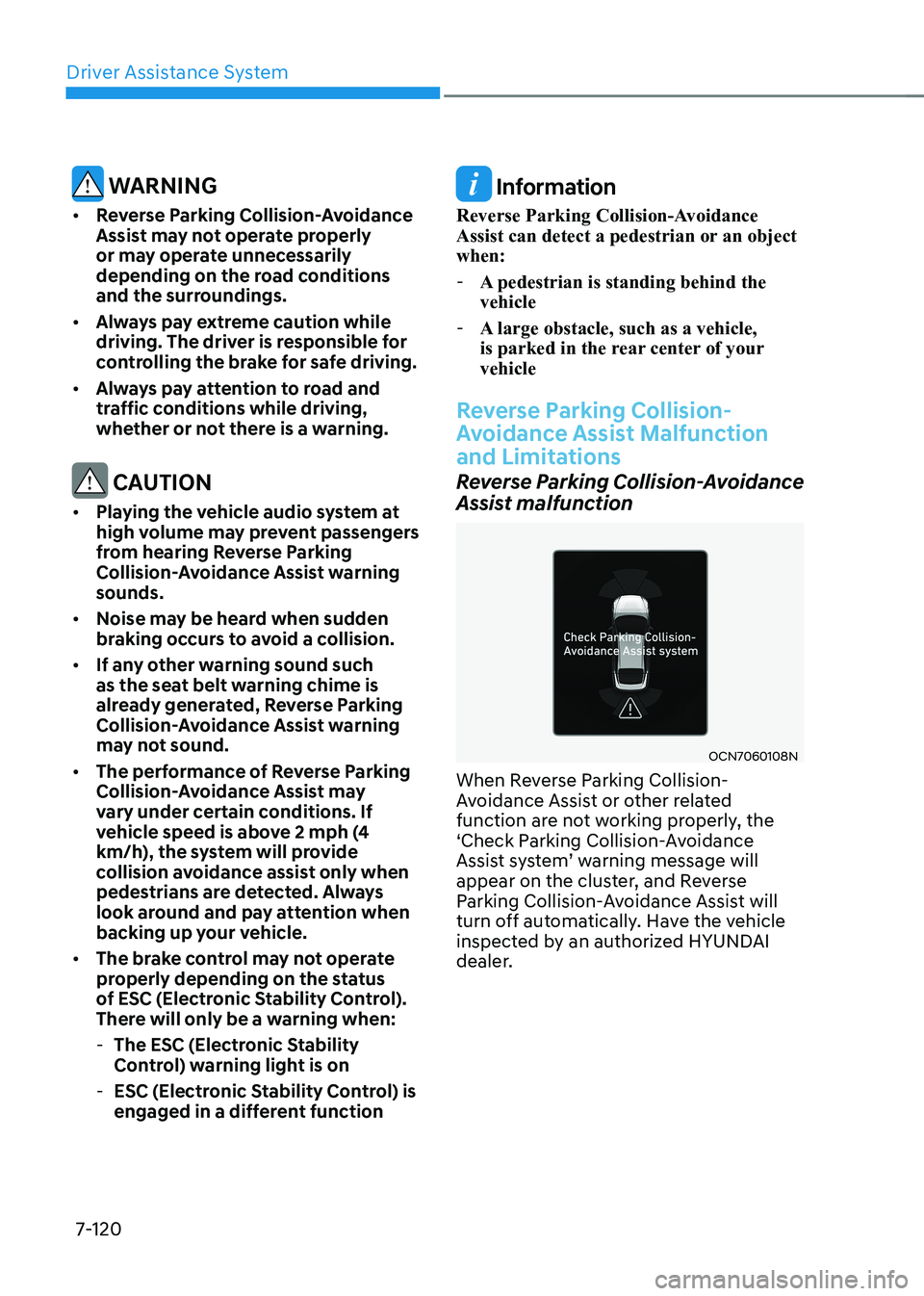
Driver Assistance System
7-120
WARNINg
• Reverse Parking Collision-Avoidance
Assist may not operate properly
or may operate unnecessarily
depending on the road conditions
and the surroundings.
• Always pay extreme caution while
driving. The driver is responsible for
controlling the brake for safe driving.
• Always pay attention to road and
traffic conditions while driving,
whether or not there is a warning.
CAUTION
• Playing the vehicle audio system at
high volume may prevent passengers
from hearing Reverse Parking
Collision-Avoidance Assist warning sounds.
• Noise may be heard when sudden
braking occurs to avoid a collision.
• If any other warning sound such
as the seat belt warning chime is
already generated, Reverse Parking
Collision-Avoidance Assist warning
may not sound.
• The performance of Reverse Parking
Collision-Avoidance Assist may
vary under certain conditions. If
vehicle speed is above 2 mph (4
km/h), the system will provide
collision avoidance assist only when
pedestrians are detected. Always
look around and pay attention when
backing up your vehicle.
• The brake control may not operate
properly depending on the status
of ESC (Electronic Stability Control).
There will only be a warning when:
- The ESC (Electronic Stability
Control) warning light is on
- ESC (Electronic Stability Control) is
engaged in a different function
Information
Reverse Parking Collision-Avoidance
Assist can detect a pedestrian or an object when: - A pedestrian is standing behind the vehicle
- A large obstacle, such as a vehicle,
is parked in the rear center of your vehicle
Reverse Parking Collision-
Avoidance Assist Malfunction
and Limitations
Reverse Parking Collision-Avoidance
Assist malfunction
OCN7060108N
When Reverse Parking Collision-
Avoidance Assist or other related
function are not working properly, the
‘Check Parking Collision-Avoidance
Assist system’ warning message will
appear on the cluster, and Reverse
Parking Collision-Avoidance Assist will
turn off automatically. Have the vehicle
inspected by an authorized HYUNDAI
dealer.
Page 418 of 529

07
7-121
Function disabled
OCN7H071050L
The rear view camera is used as a
detecting sensor to detect pedestrians. If
the camera lens is covered with foreign
material, such as snow or rain, it may
adversely affect camera performance
and Reverse Parking Collision-Avoidance
Assist may not operate properly. Always
keep the camera lens clean.
OCN7H070009
The rear ultrasonic sensors are located
inside the rear bumper to detect objects
in the rear area. If the sensors are
covered with foreign material, such as
snow or rain, it may adversely affect
sensor performance and Reverse Parking
Collision-Avoidance Assist may not
operate properly. Always keep the rear bumper clean.
„„Rear view camera „„Rear ultrasonic sensor
OCN7060127NOCN7060128N
The ‘Rear camera error or blockage’
or ‘Parking sensor error or blockage’
warning message will appear on the
cluster if the following situations occur:
- The rear view camera is covered with foreign material, such as snow or rain,
etc.
- There is inclement weather, such as heavy snow, heavy rain, etc.
If this occurs, Reverse Parking Collision-
Avoidance Assist may turn off or may not
operate properly. Check whether the rear
view camera and rear ultrasonic sensors
are clean.
Page 422 of 529
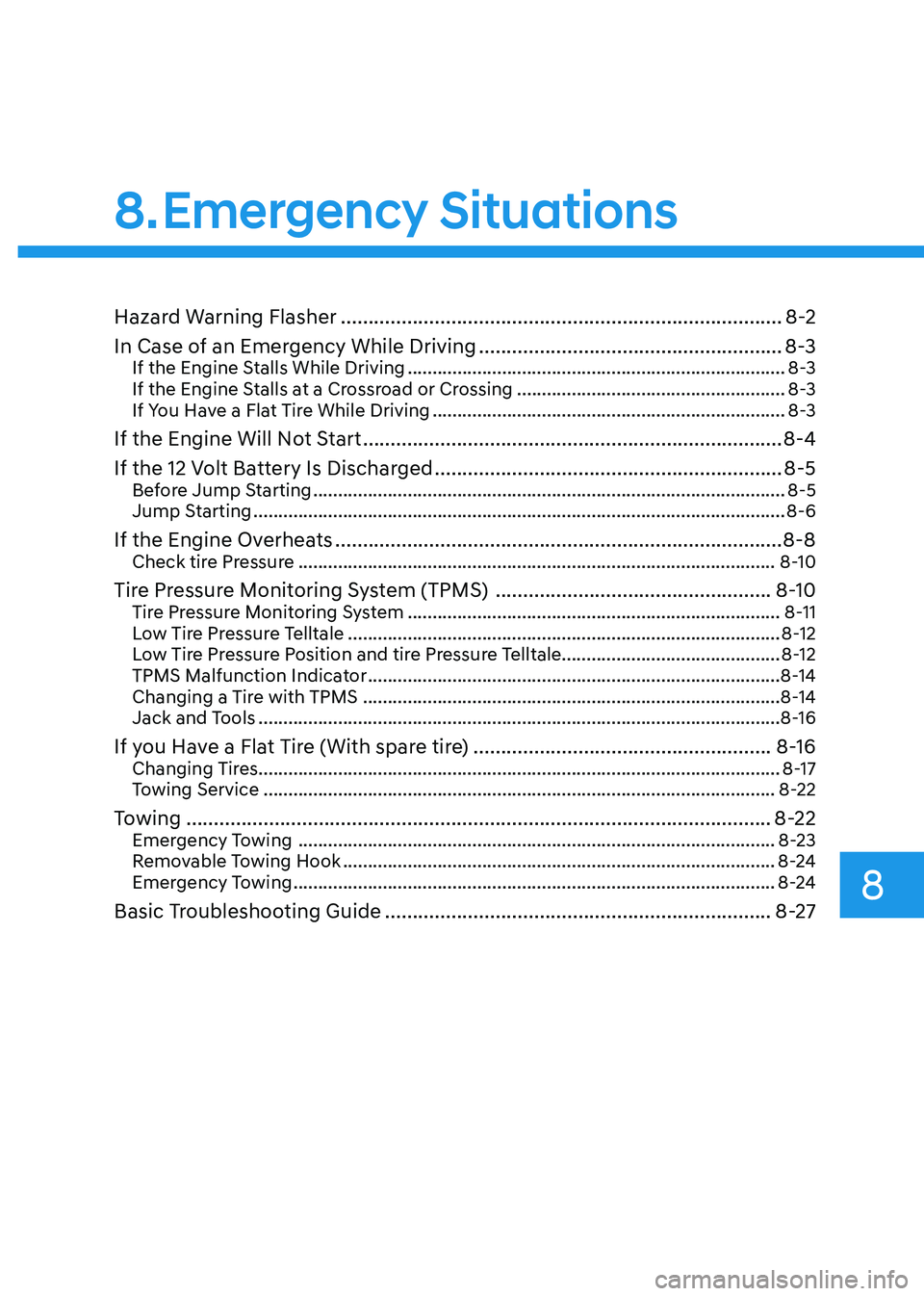
Hazard Warning Flasher ................................................................................ 8-2
In Case of an Emergency While Driving .......................................................8-3
If the Engine Stalls While Driving ............................................................................ 8-3
If the Engine Stalls at a Crossroad or Crossing ......................................................8-3
If You Have a Flat Tire While Driving ....................................................................... 8-3
If the Engine Will Not Start ............................................................................ 8-4
If the 12 Volt Battery Is Discharged ............................................................... 8-5
Before Jump Starting ............................................................................................... 8-5
Jump Starting ........................................................................................................... 8-6
If the Engine Overheats ................................................................................. 8-8
Check tire Pressure ................................................................................................ 8-10
Tire Pressure Monitoring System (TPMS) ..................................................8-10
Tire Pressure Monitoring System ........................................................................... 8-11
Low Tire Pressure Telltale ....................................................................................... 8-12
Low Tire Pressure Position and tire Pressure Telltale............................................ 8-12
TPMS Malfunction Indicator ................................................................................... 8-14
Changing a Tire with TPMS .................................................................................... 8-14
Jack and Tools ......................................................................................................... 8-16
If you Have a Flat Tire (With spare tire) ......................................................8-16
Changing Tires ......................................................................................................... 8-17
Towing Service ....................................................................................................... 8-22
Towing .......................................................................................................... 8-22
Emergency Towing ................................................................................................ 8-23
Removable Towing Hook ....................................................................................... 8-24
Emergency Towing ................................................................................................. 8-24
Basic Troubleshooting Guide ...................................................................... 8-27
8. Emergency Situations
8
Page 423 of 529
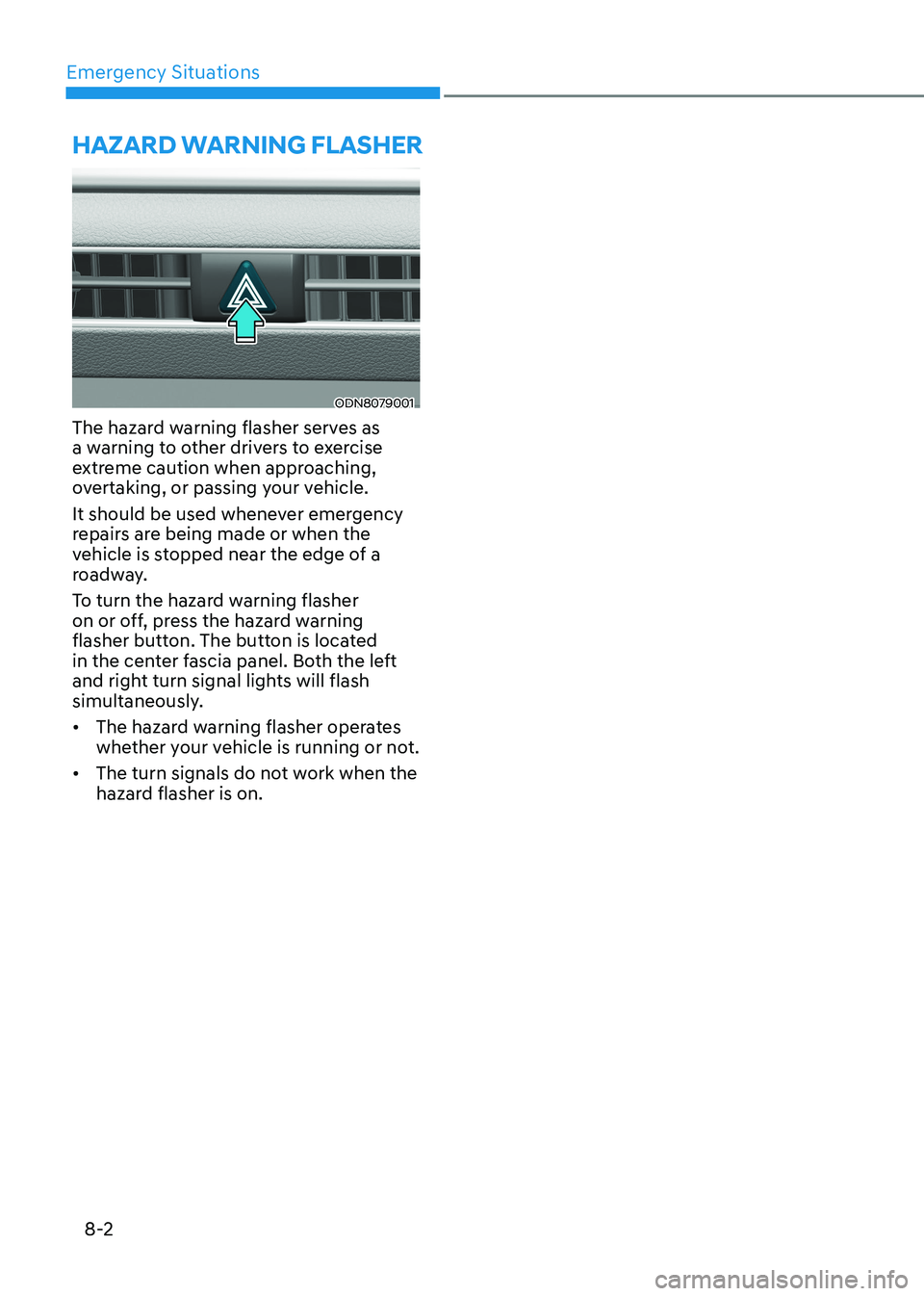
Emergency Situations
8-2
Hazard Warning FlasHer
ODN8079001
The hazard warning flasher serves as
a warning to other drivers to exercise
extreme caution when approaching,
overtaking, or passing your vehicle.
It should be used whenever emergency
repairs are being made or when the
vehicle is stopped near the edge of a
roadway.
To turn the hazard warning flasher
on or off, press the hazard warning
flasher button. The button is located
in the center fascia panel. Both the left
and right turn signal lights will flash
simultaneously. • The hazard warning flasher operates
whether your vehicle is running or not.
• The turn signals do not work when the
hazard flasher is on.
Page 424 of 529
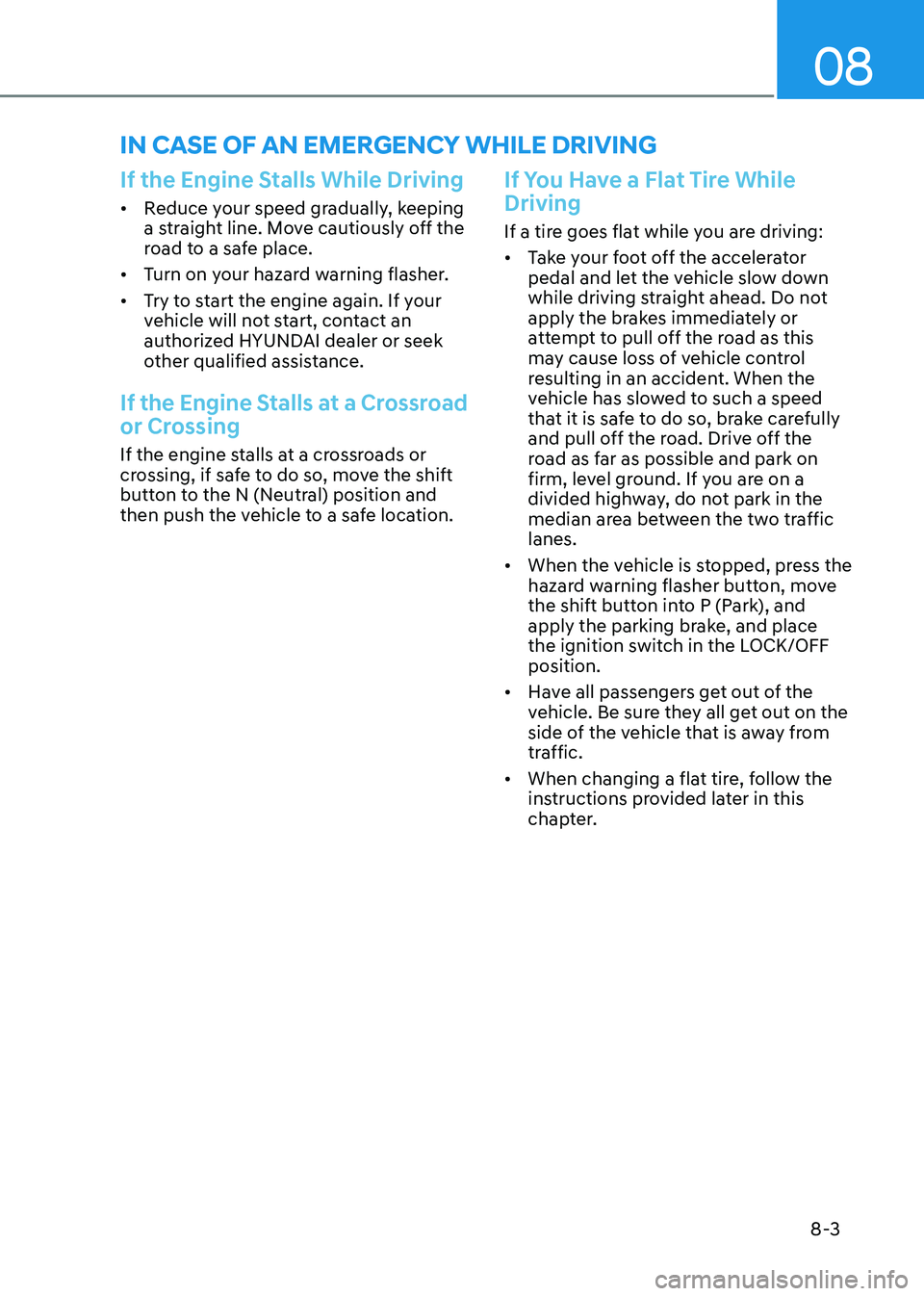
08
8-3
in Case oF an emergenCy WHile driving
If the Engine Stalls While Driving
• Reduce your speed gradually, keeping
a straight line. Move cautiously off the
road to a safe place.
• Turn on your hazard warning flasher.
• Try to start the engine again. If your
vehicle will not start, contact an
authorized HYUNDAI dealer or seek
other qualified assistance.
If the Engine Stalls at a Crossroad
or Crossing
If the engine stalls at a crossroads or
crossing, if safe to do so, move the shift
button to the N (Neutral) position and
then push the vehicle to a safe location.
If You Have a Flat Tire While Driving
If a tire goes flat while you are driving: • Take your foot off the accelerator
pedal and let the vehicle slow down
while driving straight ahead. Do not
apply the brakes immediately or
attempt to pull off the road as this
may cause loss of vehicle control
resulting in an accident. When the
vehicle has slowed to such a speed
that it is safe to do so, brake carefully
and pull off the road. Drive off the
road as far as possible and park on
firm, level ground. If you are on a
divided highway, do not park in the
median area between the two traffic lanes.
• When the vehicle is stopped, press the
hazard warning flasher button, move
the shift button into P (Park), and
apply the parking brake, and place
the ignition switch in the LOCK/OFF position.
• Have all passengers get out of the
vehicle. Be sure they all get out on the
side of the vehicle that is away from
traffic.
• When changing a flat tire, follow the
instructions provided later in this
chapter.
Page 429 of 529
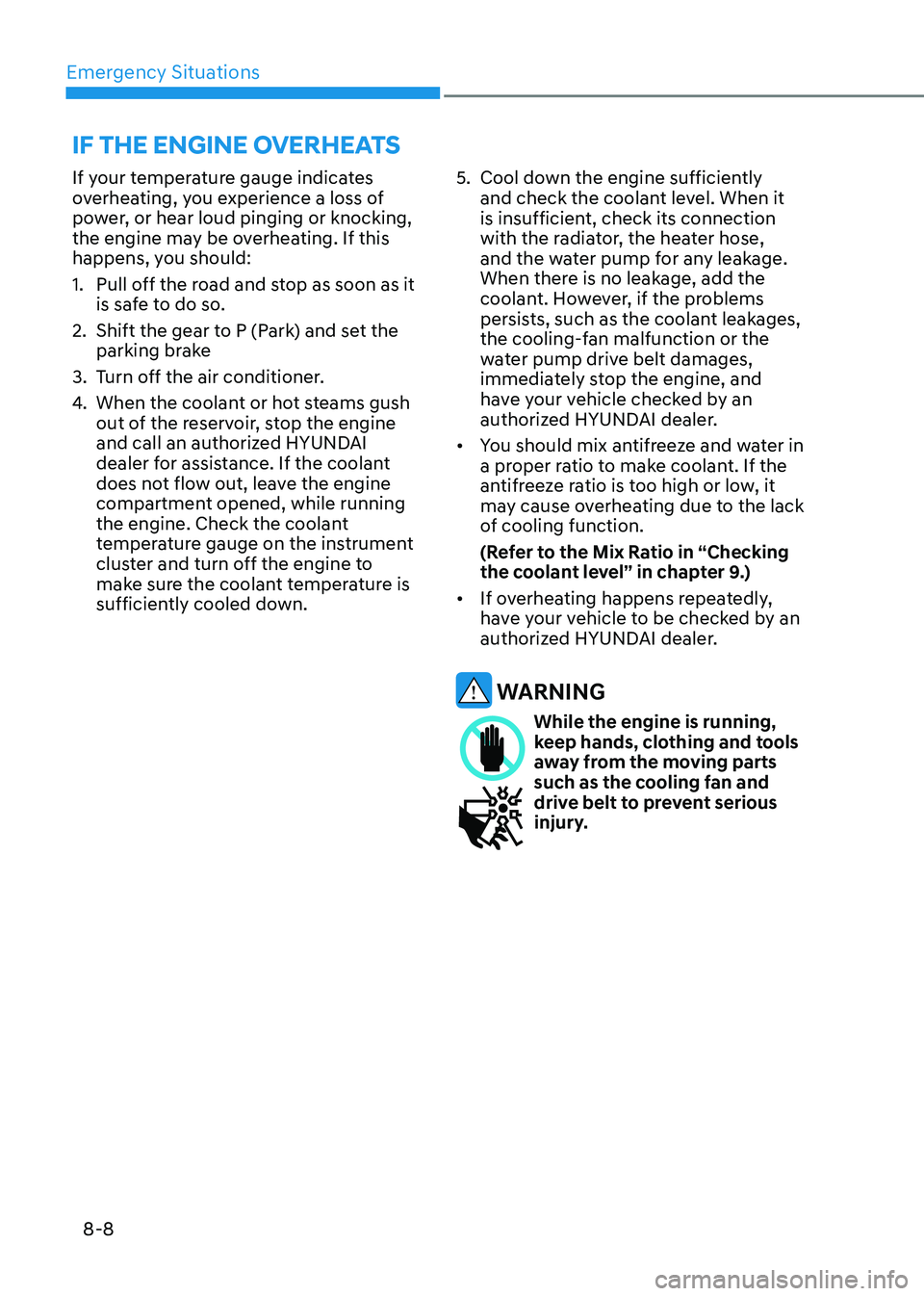
Emergency Situations
8-8
If your temperature gauge indicates
overheating, you experience a loss of
power, or hear loud pinging or knocking,
the engine may be overheating. If this
happens, you should:
1. Pull off the road and stop as soon as it
is safe to do so.
2. Shift the gear to P (Park) and set the parking brake
3. Turn off the air conditioner.
4. When the coolant or hot steams gush
out of the reservoir, stop the engine
and call an authorized HYUNDAI
dealer for assistance. If the coolant
does not flow out, leave the engine
compartment opened, while running
the engine. Check the coolant
temperature gauge on the instrument
cluster and turn off the engine to
make sure the coolant temperature is
sufficiently cooled down. 5. Cool down the engine sufficiently
and check the coolant level. When it
is insufficient, check its connection
with the radiator, the heater hose,
and the water pump for any leakage.
When there is no leakage, add the
coolant. However, if the problems
persists, such as the coolant leakages,
the cooling-fan malfunction or the
water pump drive belt damages,
immediately stop the engine, and
have your vehicle checked by an
authorized HYUNDAI dealer.
• You should mix antifreeze and water in
a proper ratio to make coolant. If the
antifreeze ratio is too high or low, it
may cause overheating due to the lack
of cooling function.
(Refer to the Mix Ratio in “Checking
the coolant level” in chapter 9.)
• If overheating happens repeatedly,
have your vehicle to be checked by an
authorized HYUNDAI dealer.
WARNING
While the engine is running,
keep hands, clothing and tools
away from the moving parts
such as the cooling fan and
drive belt to prevent serious
injury.
iF tHe engine overHeats
Page 430 of 529
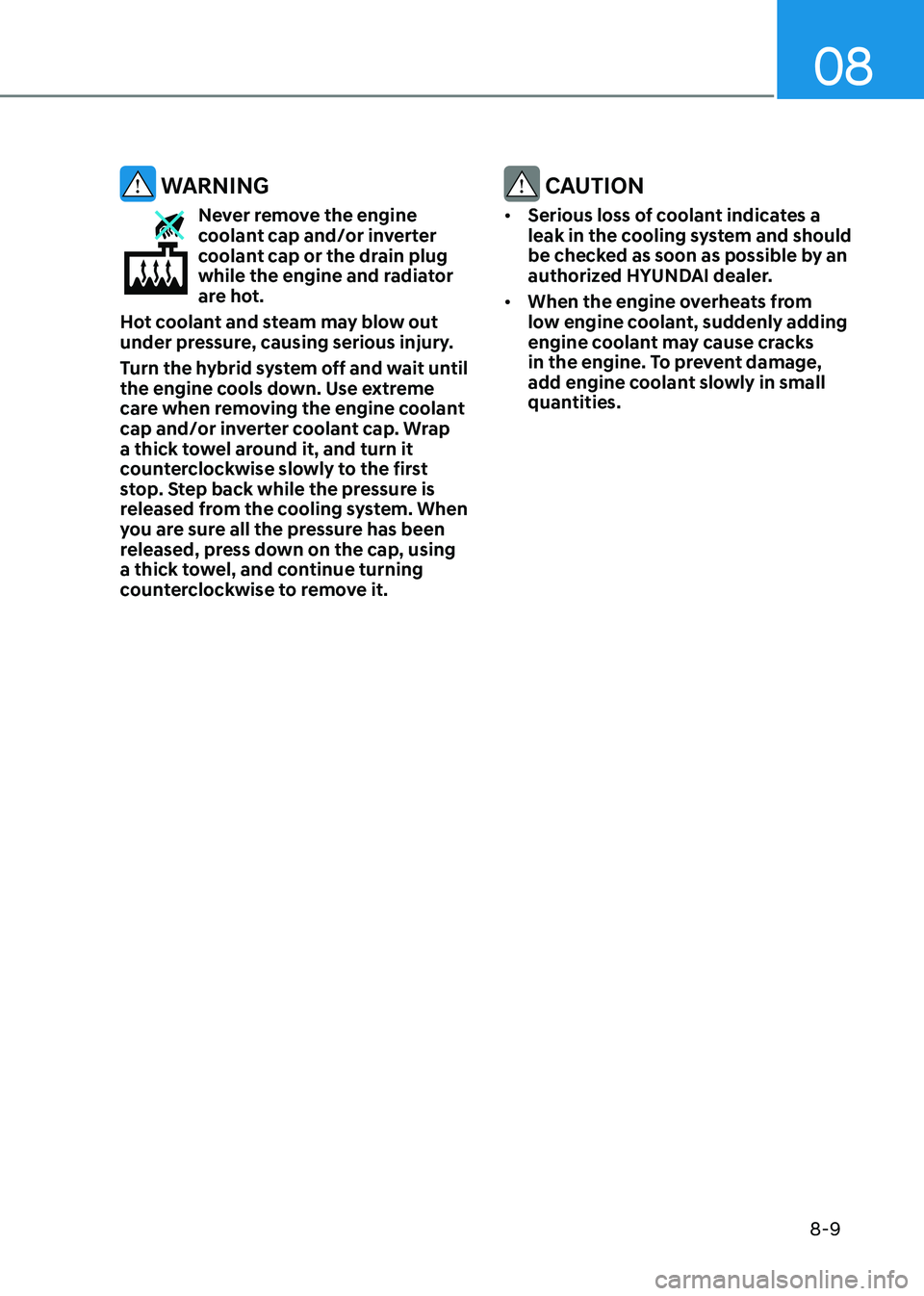
08
8-9
WARNING
Never remove the engine
coolant cap and/or inverter
coolant cap or the drain plug
while the engine and radiator
are hot.
Hot coolant and steam may blow out
under pressure, causing serious injury.
Turn the hybrid system off and wait until
the engine cools down. Use extreme
care when removing the engine coolant
cap and/or inverter coolant cap. Wrap
a thick towel around it, and turn it
counterclockwise slowly to the first
stop. Step back while the pressure is
released from the cooling system. When
you are sure all the pressure has been
released, press down on the cap, using
a thick towel, and continue turning
counterclockwise to remove it.
CAUTION
• Serious loss of coolant indicates a
leak in the cooling system and should
be checked as soon as possible by an
authorized HYUNDAI dealer.
• When the engine overheats from
low engine coolant, suddenly adding
engine coolant may cause cracks
in the engine. To prevent damage,
add engine coolant slowly in small
quantities.